- History of merit badges (Boy Scouts of America)
-
For history regarding individual merit badges, see Merit badge (Boy Scouts of America).
Merit badge Owner Boy Scouts of America Created 1910 The history of merit badges in the Boy Scouts of America (BSA) has been tracked by categorizing them into a series of merit badge types. In addition to the Boy Scouts of America, many other Scouting and Scouting-like organizations around the world, such as Pathfinders, Baden-Powell Scouts and Royal Rangers, issue merit badges or their equivalent; though they are sometimes called honors or proficiency badges. Other organizations, such as fire brigades, issue badges or awards that they refer to as merit badges, but that are in some respects different from the badges awarded by the BSA.
Merit badges have been an integral part of the Scouting program since the start of the movement in the United Kingdom on August 1, 1907, and are an important part of the uniform and insignia of the Boy Scouts. Scouting came to the United States in 1910; the BSA quickly issued an initial list of just 14 merit badges, but did not produce or award them. In 1911, the BSA manufactured the first official 57 merit badges and began awarding them.[1][2] The number of badges available has been as high as 127 in 1975 and again in 1987.[3] As of September 2011, the number of badges available is 127 again.[3] Merit badge types are identifiable by the cloth and manufacturing process used to make them. The classification of badges into types came about as a way for collectors to categorize and classify their collections. Merit badge collectors often collect other Scouting memorabilia as well.
Contents
Purpose of merit badges
Merit badges exist to encourage Scouts to explore areas that interest them and to teach them valuable skills in Scoutcraft.[4] The award of merit badges sometimes leads to careers and lifelong hobbies.[5] Scouts earn a merit badge by satisfying specified criteria; a Court of Honor is then held to present the badge. Scouts can earn badges at any point in their Scouting career, although this was not always the case — in the 1960s, Scouts first had to earn the rank of First Class Scout before being allowed to work on and earn badges.[6] The higher ranks of Star, Life Scout and Eagle require merit badges be earned. Certain badges are mandatory to receive these higher ranks. For a few years during the 1980s and 90s, First Aid merit badge was a requirement for the First Class Scout rank.[7] Other mandatory badges include Citizenship in the Community and Environmental Science (see full list). The number of merit badges required for each of these higher ranks has varied historically, as has the ratio of mandatory merit badges and non-mandatory badges for those ranks.[8] Since 2005, Scouts must earn a total of 21 merit badges for the Eagle Scout rank, 12 of which must be from the mandatory list. Once Scouts attain the Eagle rank, they can earn Eagle Palms, a core requirement of which is earning more merit badges.[9]
Badge history
The BSA changes the design, name, and availability of merit badges depending on various factors such as their popularity, shifts in the focus of the Scouting program, and changes in society.[3] Of the original 57 merit badges from 1911,[2] only 11 are still available that also still have the same basic design motif (Architecture, Art, Athletics, Chemistry, First Aid, Lifesaving, Music, Plumbing, Public Health, Scholarship, and Surveying).[10][not in citation given] Of those 11, only five were made available in each "generation" of the 10 merit badge types (these are Architecture, Art, Chemistry, Plumbing, and Public Health). The remaining six were not reproduced in a short lived "generation" of merit badges, Type I.[10][not in citation given]
Examples of merit badge change due to the degree of popularity/interest in a subject include "Interpreting", which only existed from 1911 to 1952, when it was dropped; and "Genealogy" which was added in 1972 when interest in that subject increased.[11]
An example of merit badges reflecting changes in the focus of the Scouting program is "Civics", which was originally the only citizenship-related merit badge. In 1952, the BSA split "Civics" into four separate badges, which were in turn modified several times. Since 1991, the badges in this group are "Citizenship in the Community", "Citizenship in the Nation", "Citizenship in the World", and "Family Life", all four of which are currently on the mandatory list for Eagle Scout.[12]
The "First Aid to Animals" and "Plant Science" merit badges have both evolved due to societal changes. "First Aid to Animals" was one of the original merit badges in 1911 but was dropped in 1972.[13] It was resurrected as "Veterinary Science" in 1973[13] with a focus on small pet-type animals vs. farm animals. It was renamed "Veterinary Medicine" in 1995.[14] Merging of merit badges can be seen in "Plant Science", into which all crop growing merit badges were merged in the 1970s.[15] Similarly, most of the merit badges related to animal husbandry were merged into "Animal Science".[16][17]
The "Personal Health" merit badge was an original 1911 badge with a heart motif.[18] It was merged with the "Physical Development" badge and was replaced in 1952 with the "Personal Fitness" badge.[18] It was redesigned in 1969, displaying a youth in gym gear doing what appears to be a jumping jack exercise.[18]
The merit badges on the mandatory list for Eagle rank have changed several times; "First Aid" is the only merit badge that has always been on the mandatory list for Eagle. In 1969, the BSA began manufacturing those merit badges that are required in order to obtain the rank of Eagle Scout with a silver border instead of the green border used on other merit badges.[19] In honor of the 100th anniversary of the BSA, a historical merit badge program was announced by BSA. Scouts could earn any of the four merit badges: Carpentry, Pathfinding, Signaling, and Tracking. Each had been previously retired in 1952, except Signaling, which was discontinued in 1992. These could be used as electives for Star, Life and Eagle ranks, and had to be started and completed during 2010; after which these badges would again be retired.[20] There have been a number of discontinued merit badges over the years.
A new merit badge for Robotics was jointly announced by NASA and the Boy Scouts of America in July, 2011.[21] This new badge recognizes the importance of STEM (science, technology, engineering, and math) and the 'wide-reaching impact of robotics'.[22] The BSA worked for 14 months to develop this new badge, collaborating with organizations such as iRobot, Vex Robotics, the Boston Museum of Science, Carnegie Mellon Robotics Academy and NASA.[23] The BSA currently has 31 STEM related merit badges.
Types of merit badges
According to collectors and badge historians,[citation needed] there have been 11 major styles of merit badges: Types A, B, C, D, E, F, G, H, I, J,[24] and K.[25]
Type A
Front/Reverse (Gardening) Essential facts Description 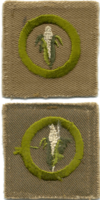 [26]
[26]Nickname: square[27]
Years of Issue:
1911–1933[27]Background Type A merit badges were manufactured in rolls and then cut into squares approximately 2" (5 cm) square, hence its nickname square.[27] Front Type A badges are known by their square or rectangular shaped cloth with the circular embroidered design. During one period of time, these badges were distributed in a roll containing many badges, with each individual badge being cut from the roll. Uncut rolls are said to exist.[28] Reverse Some Type A, B, and C badges bear black watermarks or partial watermarks of the BSA emblem on the back as these were printed on the back of the rolls at certain intervals.[27] Type B
Front/Reverse (Public Health) Essential facts Description 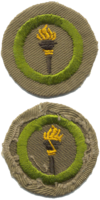
Nickname: wide border[29]
Years of Issue:
1934–1935[29] Unusually large sizeBackground Some Type B and C badges retained the same cloth color as Type A, but most came in a darker tan/brown cloth.[citation needed] Front Type B merit badges were the first badges to be manufactured with a smooth, round shape, which the manufacturer produced by folding the badge's edge under the back and crimping it.[29] Type C, D, and E badges were also manufactured in this manner, hence Types B–E are referred to as crimped. Type B badges have a diameter of about 1¾" (44 mm) after crimping. Type B has a margin of 3/16" to 1/4" (5–6 mm) between the edge of the badge and the embroidered green ring; because this margin is wider than in the Type C badge.[30] Reverse As with Type A, some Type B badges bear watermarks on the back.[27] Type C
Front/Reverse (Civics) Essential facts Description 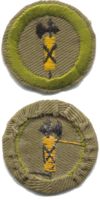
Nickname: narrow border, narrow tan
Years of Issue:
1936–1946[29]Background Type C merit badges were made from the same type of cloth as Type B badges, but were a little smaller in width.[31] Front The diameter of a Type C badge from outer edge to outer edge is about 1½" (38 mm), with the distance from the crimp to the outer edge of the green ring being 1/8" (3 mm).[29] Size is the only difference in a Types B and C;[29] hence the nicknames narrow border and narrow tan. In fact, all Type C, D and E badges are the same size. Compare Types B and C side-by-side; the difference in the distance from the outer crimp edges to the green rings is obvious.[citation needed] Beginning with Type C, all merit badges have been made with a diameter of 1½" (38 mm), except for a few Type I designs (see below). Most Type C badges were not made after 1942 (see Type D section below); only the Air Scout aviation blues, which came in four designs, were made in Type C from 1942–46.[32] These had the standard Type C cloth, but were fully embroidered with blue backgrounds inside a blue ring. This is the only time badges were made with blue rings.[3][31] Reverse As with Type A, some Type C badges bear watermarks on the back. Type C, D, and E merit badges all have sizing on the back, which serves as a stiffener to help the badge retain its crimp.[31] Type D
Front/Reverse (Camping) Essential facts Description 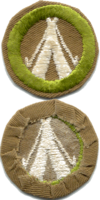
Nickname: fine twill, sand twill[33]
Years of Issue:
1942–1946[33]Background Type D merit badges were made from a lighter weight cloth with a much finer weave and lighter tan color than Type C badges because the heavier, thicker weave material that Type C badges were made from was needed to make uniforms needed during World War II.[33] This is the only difference in a Type C and Type D.[34][35] Front Because of its finer weave twill material, Type D badges are called fine twill.[33] Another name for them is sand twill because of their sandy color.[33] The only Type C badges made during this era were the afore–mentioned Type C aviation–blues. Because sand twills were made for such a short time many decades ago; they are rather rare.[35] Reverse As with Type C, Type D badges have sizing on the back.[citation needed] Type E
Front/Reverse (Dog Care) Essential facts Description 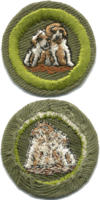 [36]
[36]Nickname: khaki green, khaki
Years of Issue:
1947–1960[33] Last type with crimped edgesBackground Type E merit badges were made from the same material as Type C badges, but the color is a decidedly darker green, hence the nickname khaki green.[33] This is the only difference in a Type C and Type E.[37] Front Serious collectors have Type B, C, D, and E merit badges recrimped to restore their original appearance as many badges lose their neat appearance over the years if the merit badge is not cared for properly. If a Type E badge has had significant washings or sun exposure it can be hard to tell from a Type C.[38] Reverse As with Type C, Type E badges have sizing on the back. Type F
Front/Reverse (Swimming) Essential facts Description 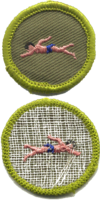
Nickname: khaki twill, rolled edge twill[39]
Years of Issue:
1961–1968[39] Not all badges appeared in this typeBackground Type F badges replaced the earlier crimped edge badges with a "rolled" edge, which is stitched around the outside to prevent unraveling..[40] Front Type F was introduced concurrently with Type G (see below), and both types were manufactured together for several years. The difference in the motif is that whereas Type F badges had a plain background, Type G badges were completely embroidered inside the green ring.[39] Some badge motifs had been made this way since Type A; they moved directly to Type G and never appeared in Type F.[40] Reverse The BSA introduced an extra layer of cloth backing underneath the khaki cloth. Type F used gauze or cheese cloth and subsequent badge types used a fuller solid cloth backing.[40] Type G
Front/Reverse (Forage Crops) Essential facts Description 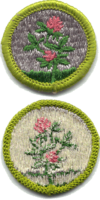 [41]
[41]Nickname: cloth back[39]
Years of Issue:
1961–1971[39]Background While all Type G badges have full embroidery inside the green ring, there were a few Type A, B, C, D, and E merit badges with full embroidery and hence do not exist as Type F merit badges;[39] examples are: "Foundry Practice", "Grasses, Legumes, and Forage Crops" (later shortened to "Forage Crops"), "Farm Layout and Building Arrangement", and "Farm Home and its Planning". Front In 1969, the BSA started issuing silver-bordered badges for those badges that were on the mandatory list for Eagle rank.[39] Silver–bordered badges appear in Type G, H, and J. Consequently, the border color of a badge will change when it goes on and off the mandatory list. A good example is "Camping" Type H, which had a green border from 1973 to 1977, yet silver border before and after that;[42] so this particular green border "Camping" variety is fairly rare.[citation needed] Reverse Type G badges were the first to appear with a full cloth backing hence the nickname cloth back.[39] Type H
Front/Reverse (Collections) Essential facts Description 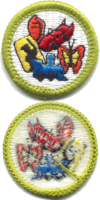
Nickname: plastic back[43]
Years of Issue:
1972–2002[43]Background Type H merit badges are made with a plastic–coated backing, hence the nickname plastic back.[43] The plastic coating is most commonly clear,[43] but is also found in a milky white color. From 1972 until sometime after 1980, blue plastic–coated merit badges were often issued. Over a hundred different types of blue-plastic back badges are known to exist. On badges made out of blue cloth, it can be difficult to tell if the plastic is clear or blue.[44][45] Front Type G, H, I and J badges are all fully embroidered.[43] As they were made for 30 years, Type H merit badges are by far the most common.[citation needed] Reverse Type H and all subsequent badges have both the full cloth back of a Type G[citation needed] and a plastic coated backing for durability.[43] Type I
Front/Reverse (White Water) Essential facts Description 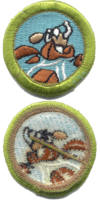
Nickname: computer designed[43]
Years of Issue:
1993–1995[43]Background Type I merit badges were designed using computers, hence the nickname computer design. The background stitching is flatter from that of Type G, H, and J badges and has the appearance of having punched holes, but the most obvious difference is in the green border––it is no longer rolled, but flat. Front The BSA decided to phase in these badges beginning in 1993 and were discontinued in 1995. Only 30 varieties appear as Type I.[43] So while not that old, they are also not that common.[citation needed] They were made in two sizes: 38 mm and 42 mm.[citation needed] Two different sizes of merit badges can not be lined up neatly on the same sash. These badges came individually packaged in plastic bags with identification labels.[46] Reverse There is a lockstitch and a brown ring stitched just inside the green ring on the obverse side of a Type I badge.[citation needed] Type J
Front/Reverse (Fish and Wildlife Management) Essential facts Description 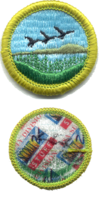
Nickname: Scout Stuff[citation needed]
Years of Issue:
2002–present[47]Background The BSA started putting its supply division logo on all patches (ranks, position, numerals, etc.) in 2002 to reduce counterfeiting and show support for the American labor force.[47] Front The front of a Type J looks just like the front of Type H badges. Reverse The only difference in a Type J merit badge and a Type H badge is that a Type J has some variation of the BSA Supply Division's Scout Stuff logo stamped on the back; hence the nickname "Scout Stuff".[citation needed] The new logo variation verifies that the insignia was produced by Boy Scout of America official suppliers and guarantees the supplier meets with BSA standards and fair labor practices.[48] Type K
Front/Reverse (Scuba Diving) Essential facts Description 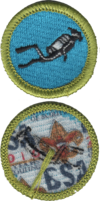
Nickname:2010, 100-year anniversary
Years of Issue:
2010–presentBackground In 2010 BSA held a contest and changed the logo to the winner's brand new design to commemorate the BSA centennial.[25][49] Front The front did not change from the type J. Reverse The reverse has parts of the centennial logo, which consists of: the BSA fleur-de-lis in gold, "2010" in red, "BSA" in blue, and "100 years of scouting" in blue.[49] Historical
Front/Reverse (Tracking) Essential facts Description 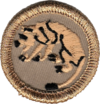
Nickname:Historical
Year of Issue: 2010Background As part of the BSA centennial, four discontinued original merit badges were available only for 2010: Carpentry, Pathfinding, Signaling and Tracking.[50] Front The fronts use the original 1911 designs on a twill background with a gold mylar border. Reverse The reverse has the centennial logo. Errors vs variations
The visual appearance of a merit badge may alter due to several reasons.[51] A "variation" is a minor change, whether intentional or not. A "manufacturing error" is a mistake or significant deviation from the BSA-approved badge design during production. A "design error" is when a badge is manufactured the way it was designed, but the design had a significant flaw.[citation needed]
Specimen variations
Variations do not appreciably alter the badge's appearance or design.[51] Two types of variations include positional changes and stitching changes. These are often caused by manufacturing variations and not classified separately. However, some variations have attained notoriety, such as the waffle weave variation found among Type C badges and the large people vs. slender people variations among Family Life badges.[52] Such variations were very common up until the 1940s and still occur, though not as often. Collectors find these variations interesting and collect such badges.[53] Examples of positional shifts among the objects comprising the motif of a merit badge include changes in the precise positioning of the tent and the mountains among Camping Type H merit badges.
Stitch patterns and thread type such as silk or cotton are not always consistent.[51] There are three known stitching variations among the Type C Personal Health merit badges: "vertical heart", "horizontal heart", and "split heart"; the variation creates the appearance of a split down the middle of the heart.[citation needed] A similar error appears in both Type H and Type J Citizenship in the Nation badges, where colors vary in order from red, white, and blue to blue, white, and red; the reasons for this are unknown. Large and small bell varieties also exist.[54] Most Type C badges come in both cotton and silk thread variations. Emergency Preparedness was made with a red cross from 1972 until 1979, when it was replaced with a green cross in 1980. This change was intentionally made. However, the color of the green is not consistent; even today, it varies between dark green, medium green, light green, and yellow green.[55][not in citation given]
Manufacturing errors
Genuine manufacturing errors occur from time to time. Some Atomic Energy Type G badges were made without a nucleus.[56] The only time a merit badge was made without a silver, green, blue (aviation blues only), or gold (2010 historicals only) border was in 1987 when Whitewater Type H badges were made with a black border.[57] Dairying appears in Type H with the cheese in both orange and burgundy. It is supposed to be orange.[58]
There have been at least three Type H badges made with little or no plastic; called plasticizing or Type G errors: American Cultures, Colonial Philadelphia,[59] and Journalism.[60] The Colonial Philadelphia patch was only available from 1975 until 1976 to Scouts in the Philadelphia region and could only be used for Eagle Palms.[59]
First Aid to Animals (FATA) Type H was made in error with a silver border in 1972. This is one of the most famous errors.[citation needed] It has a slight blue tint in the plastic back (see photos). It is believed that only about 100 of these were made and that only about 50 have survived to this day.[citation needed] Counterfeit versions of this badge error also exist.[61][62] Beekeeping merit badge Type G is also known in silver border error.[63]
Design errors
The known design errors are all from the early years. Beekeeping was made from 1914 to 1938 with only four legs instead of six simply because of human design error.[64] Beekeeping also exists in thick and thin bodies in Type C.[65] Insect Life was first made, from 1923 to 1924, with a spider on it. Since a spider is an arachnid, not an insect, the design was changed to an aphid the following year.[66] As this particular merit badge specimen was only issued for one year, it is extremely rare.[citation needed]
Spoof merit badges
Spoof merit badges are created and sold by various third-parties as a parody or joke. A multitude of emblems include snoring, surfing, computer viruses, citizenship in the universe, snow art, text messaging, whining and duct tape.[67][68]
Notes
- ^ Duersch 2003, p. xi.
- ^ a b Handbook 1911.
- ^ a b c d Henning.
- ^ Handbook 1911, p. 23.
- ^ Birkby 1998, p. 185.
- ^ Hillcourt 1965, p. 357.
- ^ Hillcourt 1979, p. 533.
- ^ U.S. Scouting 2007.
- ^ Peterson 2002.
- ^ a b Duersch 2003, pp. i–xi.
- ^ Duersch 2003, pp. 36, 40.
- ^ Duersch 2003, pp. 18–19, 29.
- ^ a b Duersch 2003, p. 33.
- ^ Duersch 2003, pp. 62.
- ^ Hillcourt 1979, p. 470.
- ^ Hillcourt1979, p. 465.
- ^ Duersch 2008, pp. 9, 27, 52, 57.
- ^ a b c Duersch 2003, p. 48.
- ^ Hillcourt 1979, p. 467.
- ^ U.S. Scouting 2011b.
- ^ Netting 2011.
- ^ NASA 2010.
- ^ Katz 2011.
- ^ Duersch 2003, pp. 1–6.
- ^ a b BSA 2010a.
- ^ Handbook 1911, p. 34.
- ^ a b c d e Duersch 2003, p. 1.
- ^ Duersch 2008, p. 1.
- ^ a b c d e f Duersch 2003, p. 2.
- ^ Duersch 2005a, pp. 14-17.
- ^ a b c Duersch 2007, pp. 15-18.
- ^ Duersch 2003, pp. 2–3.
- ^ a b c d e f g Duersch 2003, p. 3.
- ^ Kuhfeld 2005, p. 7.
- ^ a b Duersch 2005b, pp. 20-22.
- ^ Handbook 1948, p. 480.
- ^ Kuhfeld 2005, pp. 6, 7.
- ^ Duersch 2004, pp. 10–12.
- ^ a b c d e f g h Duersch 2003, p. 4.
- ^ a b c Duersch 2006, pp. 38-41.
- ^ Hillcourt 1965, p. 376.
- ^ Duersch 2003, p. 17.
- ^ a b c d e f g h i Duersch 2003, p. 5.
- ^ Kuhfeld 2005, pp. 9, 10.
- ^ Duersch 2008, pp. x, 5.
- ^ Duersch 2008, p. 5.
- ^ a b Duersch 2003, p. 6.
- ^ Duersch 2008, p. 6.
- ^ a b Murg 2008.
- ^ BSA 2010b.
- ^ a b c Duersch 2008, p. ix.
- ^ Duersch 2003, p. 29.
- ^ Duersch 2003, p. x.
- ^ Duersch 2003, pp. 18–19.
- ^ Duersch 2003, p. 28.
- ^ Duersch 2003, p. 11.
- ^ Duersch 2003, p. 63.
- ^ Duersch 2003, pp. 26.
- ^ a b Duersch 2003, p. 21.
- ^ Duersch 2003, p. 41.
- ^ Reis 2007.
- ^ Duersch 2005c, p. 31.
- ^ Duersch 2003, p. 15.
- ^ Duersch 2003, p. 14–15.
- ^ Duersch 2003, p. 14.
- ^ Duersch 2003, pp. 40.
- ^ Boy Scout Store.
- ^ Dean 2002.
Bibliography
- Handbook for Boys (1st ed.). Doubleday, Page. 1911. http://books.google.com/books?id=a7I2AAAAMAAJ.
- Pettit, Tom, ed (1948). Handbook for Boys (5th ed.). Boy Scouts of America.
- Hillcourt, William (1965). Boy Scout Handbook (7th ed.). Boy Scouts of America.
- Hines, Frederick L. (1972). Scout Handbook (8th ed.). Boy Scouts of America.
- Hillcourt, William (1979). The Official Boy Scout Handbook (9th ed.). Boy Scouts of America. ISBN 0-8395-3227-X.
- Birkby, Robert (1998). Boy Scout Handbook (11th ed.). Boy Scouts of America. ISBN 0-8395-3105-2. #32105.
- "Historical Merit Badges Help Boy Scouts Celebrate Scouting's Past". Boy Scouts of America. April 1, 2010. http://blog.scoutingmagazine.org/2010/01/12/historical-merit-badges-help-boy-scouts-celebrate-scoutings-past/.
- "Historical Merit Badge Program". Boy Scouts of America. 2010. http://www.scouting.org/scoutsource/BoyScouts/AdvancementandAwards/historical_mb_program.aspx.
- "National Logo Contest Winners". Boy Scouts of America. 2010. http://ww2.scouting.org/100years/100years/NationalLogoContestWinners.aspx.
- Duersch Jr., Fred (2003). Merit Badge Field Guide (2nd ed.). Logan, Utah: Downs Printing. OCLC 53284733.
- Duersch, Jr., Fred (November 2004). "Khaki Crimped Merit Badges 1947–1960". International Scouting Collectors Association Journal (Niles, MI: International Scouting Collectors Association) 4 (4).
- Duersch, Jr., Fred (March 2005). "Wide Crimped Merit Badges". International Scouting Collectors Association Journal (Niles, MI: International Scouting Collectors Association) 5 (1).
- Duersch, Jr., Fred (June 2005). "Fine Twill Crimped Merit Badges". International Scouting Collectors Association Journal (Niles, MI: International Scouting Collectors Association) 5 (2).
- Duersch, Jr., Fred (December 2005). "Comparisons Between Fake and Genuine First Aid to Animals Merit Badges". International Scouting Collectors Association Journal (Niles, MI: International Scouting Collectors Association) 5 (4).
- Duersch, Jr., Fred (March 2006). "Rolled Twill Edge Merit Badges". International Scouting Collectors Association Journal (Niles, MI: International Scouting Collectors Association) 6 (1).
- Duersch, Jr., Fred (June 2007). "Narrow Crimped Merit Badges". International Scouting Collectors Association Journal (Miles, MI: International Scouting Collectors Association) 7 (2).
- Duersch Jr., Fred (2008). Merit Badge Field Guide (3rd ed.). Logan, Utah: Downs Printing.
- Kuhfeld, Warren (2005). "Collecting Merit Badges The ISCA Getting Started Collecting Series". International Scouting Collectors Association. http://www.scouttrader.org/collecting/meritbadge.pdf.
- Netting, Ruth (April 12, 2011). "NASA and BSA Introduce Robotics Merit Badge". NASA Science (NASA). http://science.nasa.gov/science-news/news-and-features/nasa-and-bsa-introduce-robotics-merit-badge/.
- Henning, Stephen. "Merit Badges, Past and Present, and Their Evolution". Henning's Scouters' Pages. http://www.scouters.us/homemb.html.
- Katz, Leslie (April 10, 2011). "Boy Scouts Can Now Earn Robotics Merit Badge". CNET News. http://news.cnet.com/8301-17938_105-20052625-1.html.
- Murg, Stepanie (February 29, 2008). "Nailing Graphic Design Badge, Eagle Scout Designs Centennial Logo for Boy Scouts". Media Bistro. http://www.mediabistro.com/unbeige/nailing-graphic-design-badge-eagle-scout-designs-centennial-logo-for-boy-scouts_b4820.
- Peterson, Robert (2002). "Evolution of the Eagle Scout Award". Scouting. Boy Scouts of America. http://www.scoutingmagazine.org/issues/0211/d-wwas.html.
- Reis, Mitch (November 4, 2007). "Spotting Fake BSA Insignia, Including the Fake First Aid to Animals Merit Badge". MitchReis.com. http://mitchreis.com/bsafake.htm.
- "Boy Scout Advancement Requirement Changes". U.S. Scouting Service Project. January 1, 2006. http://www.usscouts.org/advance/changes/advchanges06.asp.
- "Boy Scout Advancement Requirements Changes Effective January 1, 2010". U.S. Scouting Service Project. January 1, 2011. http://www.usscouts.org/advance/changes/advchanges10.asp.
- "History of Required Merit Badges for Eagle Scouts". U.S. Scouting Service Project. August 6, 2007. http://www.usscouts.org/usscouts/eagle/EagleHistory.asp.
- "Merit Badges". U.S. Scouting Service Project. June 9, 2011. http://www.usscouts.org/meritbadges.asp.
- "Spoof Merit Badges". Boy Scout Store. http://www.boyscoutstore.com/store/Scripts/prodList.asp?idCategory=81.[dead link]
- Dean, Allan (October 3, 2002). "Scout Seeks Recognition for Duct Tape Merit Badge". Atlantic Highlands Herald. Archived from the original on March 25, 2005. http://web.archive.org/web/20050325065813/http://www.ahherald.com/news/2002/1003/bsa_duct_tape.htm.
External links
Boy Scouts of America Organization Advancement and recognition - Boy Scouting and Varsity Scouting awards
- Eagle Scout
- Honors and awards of the Order of the Arrow
- Merit badge
- Ranks in the Boy Scouts of America
- Venturing and Sea Scouting awards
- Quartermaster Award
- Ranger Award
- Silver Award
- Distinguished service awards
- Distinguished Eagle Scout Award
- Silver Beaver Award
- Silver Antelope Award
- Silver Buffalo Award
- Silver World Award
- Other awards
Leadership training and awards - Introduction to Leadership Skills for Troops
- Introduction to Leadership Skills for Crews
- National Advanced Youth Leadership Experience
- National Youth Leadership Training
- National Youth Leadership Training Leadership Academy
- Kodiak
- Powder Horn
- Scouter's Key Award
- Scouter's Training Award
- Seabadge
- Wood Badge
- Youth Protection program
People Events Other Regions and councils - Central Region
- Southern Region
- Western Region
- Northeast Region
- Abraham Lincoln Council
- Alabama-Florida Council
- Alameda Council
- Alamo Area Council
- Alapaha Area Council
- Allegheny Highlands Council
- Allohak Council
- Aloha Council
- Andrew Jackson Council
- Annawon Council
- Anthony Wayne Area Council
- Arbuckle Area Council
- Atlanta Area Council
- Baden-Powell Council
- Baltimore Area Council
- Bay Area Council
- Bay-Lakes Council
- Black Hills Area Council
- Black Swamp Area Council
- Black Warrior Council
- Blackhawk Area Council
- Blue Grass Council
- Blue Mountain Council
- Blue Ridge Council
- Blue Ridge Mountains Council
- Blue Water Council
- Boston Minuteman Council
- Buckeye Council
- Bucks County Council
- Buckskin Council
- Bucktail Council
- Buffalo Trace Council
- Buffalo Trail Council
- Burlington County Council
- Caddo Area Council
- Calcasieu Area Council
- California Inland Empire Council
- Calumet Council
- Cape Cod and the Islands Council
- Cape Fear Council
- Capitol Area Council
- Cascade Pacific Council
- Catalina Council
- Central Florida Council
- Central Georgia Council
- Central Minnesota Council
- Central New Jersey Council
- Central North Carolina Council
- Central Wyoming Council
- Chattahoochee Council
- Chehaw Council
- Cherokee Area Council (Oklahoma)
- Cherokee Area Council (Tennessee)
- Chester County Council
- Chicago Area Council
- Chickasaw Council
- Chief Cornplanter Council
- Chief Okemos Council
- Chief Seattle Council
- Chippewa Valley Council
- Choctaw Area Council
- Cimarron Council
- Circle Ten Council
- Coastal Carolina Council
- Coastal Empire Council
- Colonial Virginia Council
- Columbia-Montour Council
- Concho Valley Council
- Connecticut Rivers Council
- Connecticut Yankee Council
- Conquistador Council
- Cornhusker Council
- Coronado Area Council
- Cradle of Liberty Council
- Crater Lake Council
- Crossroads of America Council
- Dan Beard Council
- Daniel Boone Council
- Daniel Webster Council
- De Soto Area Council
- Del-Mar-Va Council
- Denver Area Council
- Des Plaines Valley Council
- Direct Service
- East Carolina Council
- East Texas Area Council
- Erie Shores Council
- Evangeline Area Council
- Far East Council
- Five Rivers Council
- Flint River Council
- French Creek Council
- Gamehaven Council
- Gateway Area Council
- Georgia-Carolina Council
- Gerald R. Ford Council
- Glacier's Edge Council
- Golden Empire Council
- Golden Spread Council
- Grand Canyon Council
- Grand Columbia Council
- Grand Teton Council
- Great Alaska Council
- Great Lakes Council
- Great Rivers Council
- Great Salt Lake Council
- Great Sauk Trail Council
- Great Smoky Mountain Council
- Great Southwest Council
- Great Trail Council
- Greater Alabama Council
- Greater Cleveland Council
- Greater New York Councils
- Greater Niagara Frontier Council
- Greater Saint Louis Area Council
- Greater Western Reserve Council
- Greater Yosemite Council
- Green Mountain Council
- Greenwich Council
- Gulf Coast Council
- Gulf Ridge Council
- Gulf Stream Council
- Hawk Mountain Council
- Hawkeye Area Council
- Heart of America Council
- Heart of Ohio Council
- Heart of Virginia Council
- Hiawathaland Council
- Hoosier Trails Council
- Housatonic Council
- Hudson Valley Council
- Illowa Council
- Indian Nations Council
- Indian Waters Council
- Inland Northwest Council
- Iroquois Trail Council
- Istrouma Area Council
- Jayhawk Area Council
- Jersey Shore Council
- Juniata Valley Council
- Katahdin Area Council
- Knox Trail Council
- La Salle Council
- Lake Huron Area Council
- Las Vegas Area Council
- Last Frontier Council
- Laurel Highlands Council
- Lewis and Clark Council
- Lincoln Heritage Council
- Lincoln Trails Council
- Long Beach Area Council
- Longhorn Council
- Longhouse Council
- Longs Peak Council
- Los Angeles Area Council
- Los Padres Council
- Louisiana Purchase Council
- Marin Council
- Mason-Dixon Council
- Maui County Council
- Mecklenburg County Council
- Miami Valley Council
- Mid-America Council
- Mid-Iowa Council
- Middle Tennessee Council
- Midnight Sun Council
- Milwaukee County Council
- Minsi Trails Council
- Mississippi Valley Council
- Mobile Area Council
- Mohegan Council
- Monmouth Council
- Montana Council
- Monterey Bay Area Council
- Moraine Trails Council
- Mount Baker Council
- Mount Diablo Silverado Council
- Mountaineer Area Council
- Muskingum Valley Council
- Narragansett Council
- Nashua Valley Council
- National Capital Area Council
- NeTseO Trails Council
- Nevada Area Council
- New Birth of Freedom Council
- North Florida Council
- Northeast Georgia Council
- Northeast Illinois Council
- Northeast Iowa Council
- Northeastern Pennsylvania Council
- Northern Lights Council
- Northern New Jersey Council
- Northern Star Council
- Northwest Georgia Council
- Northwest Suburban Council
- Northwest Texas Council
- Norwela Council
- Occoneechee Council
- Ohio River Valley Council
- Okefenokee Area Council
- Old Colony Council
- Old Hickory Council
- Old North State Council
- Orange County Council
- Ore-Ida Council
- Oregon Trail Council
- Otschodela Council
- Ouachita Area Council
- Overland Trails Council
- Ozark Trails Council
- Pacific Harbors Council
- Pacific Skyline Council
- Palmetto Area Council
- Patriots' Path Council
- Pee Dee Area Council
- Pennsylvania Dutch Council
- Piedmont Council (California)
- Piedmont Council (North Carolina)
- Pikes Peak Council
- Pine Burr Area Council
- Pine Tree Council
- Pony Express Council
- Potawatomi Area Council
- Potomac Council
- Prairielands Council
- Puerto Rico Council
- Pushmataha Area Council
- Quapaw Area Council
- Quivira Council
- Rainbow Council
- Redwood Empire Council
- Revolutionary Trails Council
- Rio Grande Council
- Rip Van Winkle Council
- Rocky Mountain Council
- Sagamore Council
- Sam Houston Area Council
- Samoset Council
- San Diego-Imperial Council
- San Francisco Bay Area Council
- San Gabriel Valley Council
- Santa Clara County Council
- Santa Fe Trail Council
- Scenic Trails Council
- Seneca Waterways Council
- Sequoia Council
- Sequoyah Council
- Shawnee Trails Council
- Shenandoah Area Council
- Simon Kenton Council
- Sioux Council
- Snake River Council
- South Florida Council
- South Plains Council
- South Texas Council
- Southeast Louisiana Council
- Southern New Jersey Council
- Southern Sierra Council
- Southwest Florida Council
- Southwest Michigan Council
- Stonewall Jackson Area Council
- Suffolk County Council
- Susquehanna Council
- Suwannee River Area Council
- Tall Pine Council
- Tecumseh Council
- Texas Trails Council
- Theodore Roosevelt Council
- Three Fires Council
- Three Harbors Council
- Three Rivers Council
- Tidewater Council
- Transatlantic Council
- Trapper Trails Council
- Tri-State Area Council
- Tukabatchee Area Council
- Tuscarora Council
- Twin Rivers Council
- Twin Valley Council
- Utah National Parks Council
- Ventura County Council
- Verdugo Hills Council
- Virgin Islands Council
- Voyageurs Area Council
- W. D. Boyce Council
- West Central Florida Council
- West Tennessee Area Council
- Westark Area Council
- Westchester-Putnam Council
- Western Colorado Council
- Western Los Angeles County Council
- Western Massachusetts Council
- Westmoreland-Fayette Council
- Winnebago Council
- Yankee Clipper Council
- Yocona Area Council
- Yucca Council
 Scouting and Guiding topics
Scouting and Guiding topics 
The Scouting Movement Sections Founders, pioneers, and notable leaders Prominent places International Scouting - Confédération Européenne de Scoutisme
- International Scout and Guide Fellowship
- Order of World Scouts
- Scouts-in-Exile
- International Union of Guides and Scouts of Europe
- World Association of Girl Guides and Girl Scouts
- World Federation of Independent Scouts
- World Organization of the Scout Movement
Other
Wikimedia Foundation. 2010.

